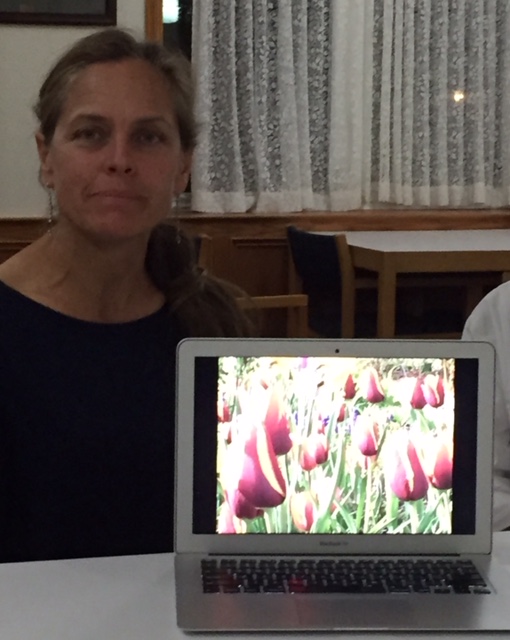 Sandra Pella, Head Gardener at Toronto Botanical Gardens shared advice about choosing and planting spring bulbs. Her photographs were beautiful and in most cases included a pollinator getting food and spreading pollen. Sandra stressed the importance of including very early blooming flowers such as Iris reticulata which blooms as early as March to give the pollinators nourishment as soon as they emerge from their winter sleep.
Sandra Pella, Head Gardener at Toronto Botanical Gardens shared advice about choosing and planting spring bulbs. Her photographs were beautiful and in most cases included a pollinator getting food and spreading pollen. Sandra stressed the importance of including very early blooming flowers such as Iris reticulata which blooms as early as March to give the pollinators nourishment as soon as they emerge from their winter sleep.
Sandra chooses and plants 20 to 25 thousand bulbs at the Toronto Botanical Gardens in the fall. Many of the bulbs she includes are new introductions that are not available in the nurseries this fall but will be in future. After seeing the photographs of the bulbs blooming in the Toronto Botanical Gardens, I highly recommend a visit to the gardens next spring.
Here is a brief summary of Sandra’s advice:
1. Begin to plant bulbs for spring in October. The soil must be cold before you begin to plant. You can continue to plant into November and December and even January as long as you can still dig the soil.
2. Be sure that your tulip bulbs touch some narcissis bulbs before they are planted. Put your tulip bulbs into a box with the narcissis bulbs and mix them together well. Plant them in combination. The squirrels will be more likely to leave your tulip bubs alone.
3. When planting, a good proportion of tulips to narcissis is 2 to 1.
4. Layer your planting. For example, dig a trench or hole 6 to 8 inches deep and put the soil you take from the trench or hole into a bucket. Place the tulip and narcissis bulbs in the bottom of the trench or hole, making sure that the bottom of the bulb makes good contact with the soil. Cover the bulbs with the soil from the bucket. Place Iris reticulata (Dutch Iris) bulbs on top. Include some crocus or snowdrop bulbs on top as well. Cover with the remaining soil. If you include some early, mid and late season tulips, you will have a long season of bloom. A few Iris reticulata to look for are ‘Katherine Hodgkin’, ‘Danfordiae’, Happiness’, ‘Seabreeze’ and ‘Harmony’
5. If you want perennial tulips, choose species tulips. Some to look for are ‘Tinka’ and ‘Peppermint Stick’. Darwin and Triumph tulips tend to be best the first year and sometimes will bloom a second year but they tend to have to be replaced. Look for ‘Gavota’, a Triumph tulip. A narcissis that naturalizes well is ‘Rip Van Winkle’
Choosing showey tulips such as Parrot Tulips will add beauty to your garden but the bulbs will have to be replaced each year.
6. Bulbs can be planted under peonies. Plant close to the crown and in fact small bulbs such as crocus can be planted on top of the crown. When the bulbs are finished, the peonies will grow and cover the foliage of the bulbs.
7. Do not cut or tie the bulb foliage. Allow it to dry out and return to the soil. You can tuck the foliage back under other perennials but leave them intact.
8. Alliums are a nice addition to the garden. A white clumping allium such as ‘Mount Everest’ is a good choice.
A final word of advice is “You have to invest some time this autumn in order to have a beautiful show of blooms next in spring and the pollinators will thank you!
